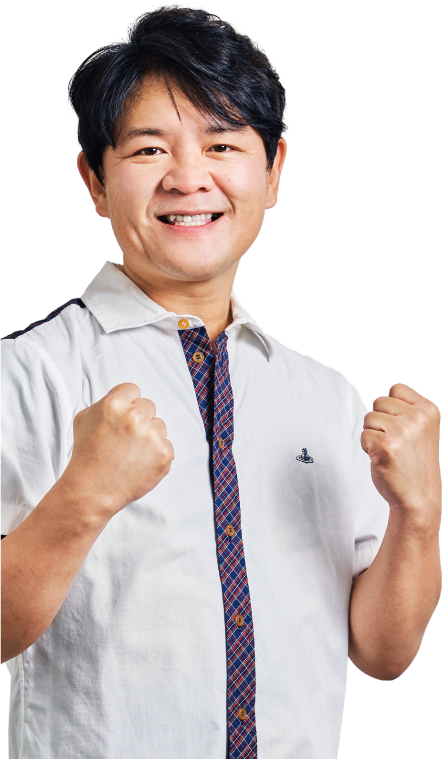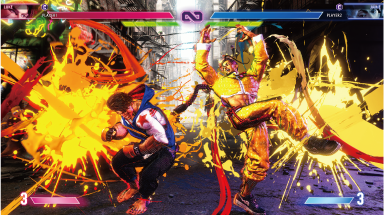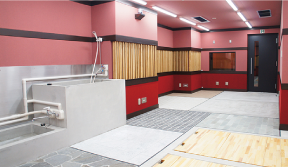- Value
Creation
Story(PDF) - CEO
Commitment - COO Growth
strategy - CHO
COMMITMENT - CFO
COMMITMENT - Development
- Corporate
Governance


Unveiling
a new era of fighting games
Ryozo Tsujimoto
Director, Executive Corporate Officer, Deputy in charge of Development Divisions
As the Head of Consumer Games Development Division 2, he has overseen development of multiple flagship series, including Monster Hunter and Street Fighter. In June 2022, he was appointed Director and Deputy in charge of Development Divisions, focusing on overall development strategy and management.
As the Head of Consumer Games Development Division 2, he has overseen development of multiple flagship series, including Monster Hunter and Street Fighter. In June 2022, he was appointed Director and Deputy in charge of Development Divisions, focusing on overall development strategy and management.
Revisiting the definition of gameplay
to maximize IP
potential
A fighting game where you don’t fight?
About five years ago, the concept proposal for Streeet Fighter 6 submitted by development team members Shuhei Matsumoto and Takayuki Nakayama was filled with various ideas that turned the previous concept of Street Fighter on its head. There were some aspects that really surprised me, such as the option not to fight and a mode where players can learn how to fight from a master before playing. Nevertheless, I had a feeling that these ideas would help to push the title to the next stage of its evolution.
Street Fighter is one of Capcom’s most iconic IPs, and first appeared on the scene as an arcade game in 1987. It has since gone on to become synonymous with fighting games, selling more than 50 million copies in the series to date. It is a natural fit for esports and has established itself as a title that can be enjoyed not only by playing but also watching. However, the fighting genre does not have a large fan base compared to shooting, action, and RPGs. In fighting games, someone always loses. Will losing motivate you, or will it stress you out and make you want to stop? While taking these points into account, the team proposed a new way to enjoy Street Fighter so that more people can understand and appreciate its appeal. Their enthusiasm to reinvigorate the fighting game genre resonated with me, so I gave the go ahead to move forward with development.

Three modes of play to bring together new
and existing
fans
The development team for Street Fighter 6 was both well-balanced and disciplined, led by the core duo of Matsumoto and Nakayama. With as many as 300 people at Capcom alone, we gave our all to achieve our goal of creating the world’s best fighting game. From the standpoint of oversight, I briefed the company’s management team on the necessary resources and gained their approval, while working with domestic and overseas subsidiaries and partners on promotion strategies to make it easier for the team to operate.
The team’s primary focus on this game was to remove the hurdles of fighting games while making it enjoyable for both new and long-time fans alike. To make it easier for newcomers to join in, we incorporated fresh concepts, such as the addition of new characters and the introduction of Modern Controls—a control method that allows players to perform special moves without having to memorize complicated button inputs.
What’s most distinctive is that we channeled the player’s perspective to offer three game modes. First is World Tour, a single-player mode in which players create their own avatar and become a disciple of different masters to learn moves while also freely traveling through the Street Fighter universe. There are many ways players can enjoy this mode besides fighting, making this an introduction in getting familiar with the game’s style. Second is the Battle Hub mode, where you can communicate and fight with players from all over the world, using avatars trained in World Tour. This mode makes it feel like you are in an arcade and someone challenged you to a game. Finally, third is Fighting Ground, a versus fighting mode which will wow even longtime fans with its cutting-edge technology. We positioned this mode as the final destination for players and worked backwards to flesh out the elements necessary to get there. We made full use of RE ENGINE to efficiently develop what felt like three games’ worth of content.
As a result, Street Fighter 6 has sold more than 2 million units worldwide in the space of about one month since its release in June 2023*. This shows that the game’s new approaches have been embraced by many players. We will provide regular content to keep it fresh and interesting, while in August we will also kick off our Capcom Pro Tour esports tournament, featuring an annual prize pool of $2 million USD.* The new battle in the world of fighting games has just begun—and we’re looking forward to tackling whatever fresh challenges come our way.
*As of July 7, 2023

Aspiring to the pinnacle of fighting with a game that appeals to all
-
When we were young, the two of us loved playing Street Fighter II at arcades, and now we are working to rekindle that joy in developing the latest title in the series. The concept was to create the pinnacle of fighting games, to the point where the people in charge of Street Fighter 7 would have a hard time besting it. In order to maintain the game feel, we set up a branding team and solidified our policies from graphics to sound and promotion.
We also collaborated with Capcom USA to make sure that the new game expressed the culture of North America, the game’s largest market. In order to make it so all players could enjoy this game, we built an intuitive user interface and also worked with visually impaired esports players to improve sound accessibility via the sound effects, etc. We’re working with our overseas subsidiaries to conduct promotional activities, such as social media, merchandising, and events, so that even people who may not play games can become more familiar with Street Fighter in their daily lives.
There is a diverse roster of characters in the game—all awaiting some new challengers! We’re also readying additional content for a wide range of players, and hope you are excited about future updates coming down the line.
-


Evolving our approach to game creation
with a comprehensive development environment
and our proprietary RE ENGINE
Aiming to simplify and streamline advanced technological development,
Capcom is an industry pioneer in integrating the facilities and environment indispensable to
game production.
This includes technological research for the RE ENGINE, along with facilities for visuals
and sound.
This proprietary development environment has enabled us to create unique
and iconic titles that truly resonate with international audiences.
Capcom is bringing forth a new form of entertainment with the convergence of creativity and
technology.
RE ENGINE
Creating more thrilling fights with Fighter Tool
I think the advantage of RE ENGINE is that it is a game development engine built in-house, so we can flexibly expand its functions as needed. Within the Engine Development Section, there are groups divided into fields such as AI and tools, and I am in charge of developing animation tools. My mission is to help bring character movement to life, which I do by utilizing controls after incorporating motion capture data (a digitized record of real human movements) into CG characters. In this sense, I support the title development team using technology.
Street Fighter 6 is the first fighting game developed with RE ENGINE. Since we didn’t yet have features optimized for fighting games, I built a new tool from scratch called Fighter Tool for adjusting the data of fighting game characters. The emphasis was on work efficiency. I designed Fighter Tool so conflicts won’t arise in the character data even when different teams, such as planning, effects, and sound, are editing at the same time, while also making it so that two different characters’ data can be implemented into the game while comparing them. I had to take a trial and error approach during development while adding functions and specification changes, but with the support of experienced colleagues, I was able to create a highly scalable tool that can stand up to the test of future updates. I hope players will enjoy all the interesting characters that were fine-tuned using this tool.
Programmer
Engine Development Section
R&D Foundational Technology Department
Daisuke Yagyu
<Credits>
Monster Hunter Rise
Street Fighter 6



New Creative Studio established to support the pinnacle of
game graphics production
Motion capture is now indispensable for game production. With this technology, an actor performs the actions of a game character in the studio while infrared cameras detect their movement, which is then converted into digital information. Recording done together with RE ENGINE using this technology makes it possible to recreate the natural and bold movements of not only human characters, but also monsters. In Street Fighter 6, the actors’ performances, such as ballet and street dance, were utilized in the dazzling moves of the game characters.
Action is the lifeblood of Capcom games. Because we are typically working to create gameplay actions for multiple projects in tandem, the schedule for our existing studio could get quite full. As such, we built a new state-of-the-art facility called Creative Studio that houses two new motion capture studios, one of which features 150 cameras, including the latest ultra-high-resolution models, and has one of the largest filming areas in Japan. This increased filming capacity makes it possible to simultaneously record up to 10 people in full-performance motion capture. We will capitalize on this three-studio system to accelerate the development process.
3D scanning studio reduces workload while raising precision
Our 3D scanning studio is one of the world’s largest and is equipped with approximately 310 cameras. Photographing people from 360° enables us to scan them as 3D objects. This significantly shortens the CG modeling process and allows us to pursue an even higher level of precision and quality.

The Dynamic Mixing Stage: our 3D audio booth reproducing realistic sounds
We use a cutting-edge Dolby Atmos system, which can also be found in movie theaters, and which uses binaural technology capable of reproducing sounds with such reality you feel as if you are right there. This enhances the immersive feel of a game by influencing players’ aural perception in addition to their visual perception.

Foley Stage: recording all types of sound effects and background sounds
The Foley Stage is where the various sound effects for games are recorded and produced. The diverse floor surfaces and myriad recording tools make it possible to recreate any number of scenes. Using the same techniques as recent Hollywood movies, we are able to produce high-quality game sound, offering an even more immersive experience.





